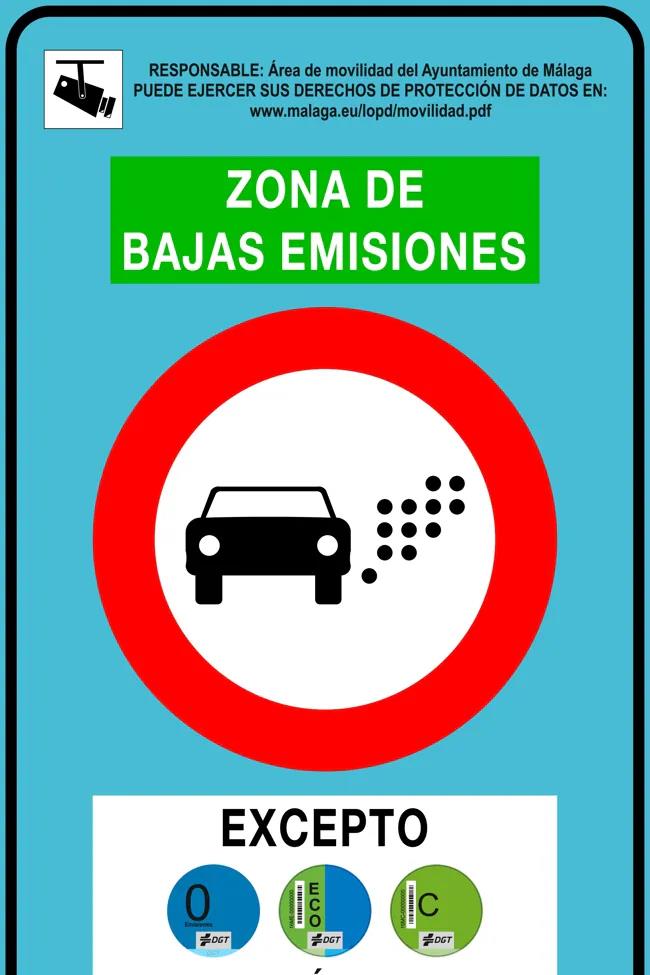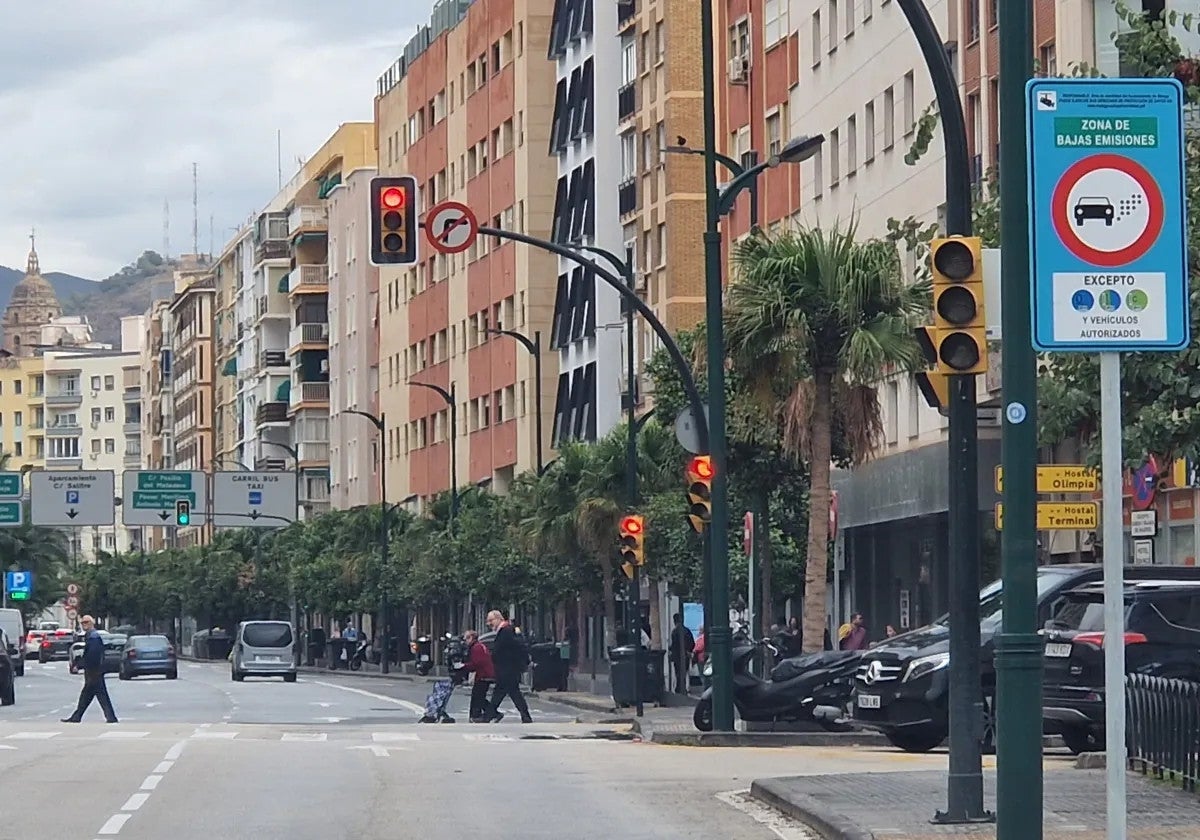Ten key things you need to know as Malaga activates system to drive polluting vehicles from city centre
For the first year the city council will not issue fines and for now it has ruled out sending warning letters to possible offenders. The traffic regulation also includes new rules on speeding and electric scooters, all effective as of last Saturday
On Saturday 30 November the low emission zone (Zona de Bajas Emisiones - ZBE) to prevent the most polluting vehicles from entering Malaga city centre was activated. The new mobility ordinance took effect after publication on Friday in the BOP official provincial gazette. This followed more than a year of paperwork and a double participatory process of consultation. Malaga city council has launched a website with all possible information on the service and to respond to queries (although not in English, there are useful images to explain the ZBE).
1: If you pay road tax (IVTM) in Malaga city
In general terms drivers who pay their road tax within the provincial capital should be reassured given that the penalties, from next year onwards, will focus mainly on the most polluting vehicles, but primarily those from outside the city. The idea behind this is that local families can continue to use up the useful life of their old car but, if they decide to sell it and it is without a label or it is classed only as a B category for emissions, the buyer will lose the right to drive it in the ZBE.

From 2025 onwards the city expects to collect just under 12 million euros per year in fines and, in the first instance, to eliminate approximately 26% of road traffic.
2: First year of grace
In the first year there will be no fines so that drivers can learn the ZBE ropes, be checked out and become accustomed to the system. Those whose vehicles are registered in the city will have no problems, at least for the first five years. In principle Malaga city council has ruled out issuing written notifications of any ZBE offence that is not yet in force, as was done with Álamos and Carretería, for example.
The turquoise blue, vertical signs, which feature a red and white no-entry-type circle and warn of the existence of cameras to read number plates, can already be seen in a multitude of streets. They will be joined by large digital signs such as the one on Avenida de Martiricos to warn of the proximity to the zone.
3: Year-on-year restrictions
In other words: first year of operation means no problems or penalties for anyone. From the second year, at the end of 2025, access will be restricted to motor vehicles (motorbikes and cars) that do not have a sticker or a tag and are registered outside the city of Malaga. Then, from the third year onwards, B-class vehicles and those without a sticker from other municipalities will not be allowed to enter (and remember, that includes B vehicles that have been sold on, as previously stated).
So the Cero, Eco and C-class vehicles can always enter the ZBE in these first years of operation, regardless of where they are coming from, and that includes those from Malaga city.
Passenger service vehicles (PSVs) such as buses (public and private), taxis and private hire cars (VTCs in Spanish), classic cars of a certain age and lorries will also be allowed to circulate within the ZBE.
For the first four years commercial vans will be able to circulate freely with or without an environmental label (Zero, Eco, C or B). From the fifth year onwards vans domiciled in Malaga will be allowed to circulate, but those coming from outside Malaga city and lacking a sticker or tag will be banned.
All emergency vehicles will have freedom of movement.
4: Traffic targets and figures
The city council's medium-term objective is to reduce traffic by 26,000 vehicles per day. In the first year of fines collection, the estimated revenue for the municipal coffers is 11.4 million euros.
Latest studies have logged 206,000 accesses to the low emission zone with 24% of the cars coming from Malaga's surrounding metropolitan areas and a similar percentage have no environmental label on their windscreen. Of those coming from outside the city, the distribution is: 11% are from Torremolinos and the Costa del Sol, 5% from both Alhaurin towns, 4.5% from Axarquía and Rincón de la Victoria, 2% from Las Pedrizas and 1.8% from Cártama and the A-357.
The ZBE control checkpoints logging the most traffic are Paseo Antonio Machado-Avenida Ingeniero José María Garnica, Bailén-Trinidad and Avenida de Andalucía-Jardines Picasso (21,000 cars per day). Close behind (20,000) is Paseo Pablo Ruiz Picasso with Rafael Pérez Estrada.
The implementation of the ZBE has involved an investment of 4.2 million euros with 516,000 of that coming from municipal coffers. The aim is to reduce emissions of polluting gases by 13-20% by 2030.
5: Affected city areas
The ZBE in Malaga city is drawn around the following streets: Paseo Marítimo Antonio Machado, Avenida Ingeniero José María Garnica, Calle Explanada de la Estación, Plaza de la Solidaridad, Avenida de las Américas, Avenida de la Aurora, Jardines de Picasso, Avenida de Andalucía, Calle Compositor Lehmberg Ruiz, Calle Hilera, Calle Santa Elena, Calle Honduras, Calle Arango, Calle Martínez Maldonado, Avenida de Barcelona, Plaza del Hospital Civil, Avenida Doctor Gálvez Ginachero, Calle Mazarredo, Avenida del Arroyo de los Ángeles, Paseo de Martiricos, Calle Huerto de los Claveles, Calle Marqués de Cádiz, Calle Juan del Encina, Calle Empecinado, Plaza Capuchinos, Alameda de Capuchinos, Plaza Olletas, Calle Toquero, Calle Obispo González García, Calle Amargura, Calle Ferrándiz, Paseo Salvador Rueda, Calle Rafael Pérez Estrada and Paseo Marítimo Pablo Ruiz Picasso.
6: Are windscreen stickers necessary?
The ZBE comprises an area of 437 hectares of limited traffic circulation controlled by 53 checkpoints and 97 cameras.
There is no need to have the sticker physically in the vehicle. The number plate reading system will be connected to the database of Spain's Directorate-General of Traffic (DGT) so a warning is triggered if there is incorrect access. In any case, checking the label is as simple as logging on to the DGT website and entering the vehicle registration number. Physical stickers can be requested via the DGT or purchased at post offices.
7: A ZBE is not the same as a traffic-restricted zone
The ZBE is something different from the traffic-restricted areas that have been successively introduced in the old part of the city and Soho as pedestrianisation has progressed. These areas are only allowed to authorised vehicles (the museums quarter in Soho, Molina Lario, Álamos-Carretería and so on).
8: Motorbikes
Motorbikes are treated in the same way as cars for the purposes of vehicle-emission labelling and road tax (with less restrictions if registered in Malaga city).
9: Is it a Malaga thing?
This is not an initiative of Malaga city council but the application of an EU directive being implemented at a national level in Spain in cities with over 50,000 inhabitants. In Malaga province the first municipality to implement the ZBE was Estepona. Marbella, Fuengirola, Mijas, Vélez, Rincón, Benalmádena and Torremolinos are also in different stages of implementation.
Across the country there are more than 30 cities that already have it in force: the highest concentrations are in Madrid and Catalonia. It is important to check before travelling by car to any other city. In fact, there is an informative website from the Ministry of Ecological Transition that provides updates on the new areas.
10: Ordinance also affects scooters and speed limits
The new regulation also makes it compulsory to wear a helmet on scooters (also known as PMVs, personal mobility vehicles) and other issues such as the compulsory certificate for new models that must be on the DGT approved list.
The new traffic norms also change, for example, the speed limit according to the national framework. In general, the speed limit is now 50km/h on city streets unless there are further exceptions. With the ordinance now official, the limit on 80% of Malaga's streets is 30km/h for two-way, single-lane roads.

